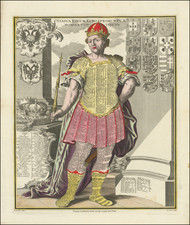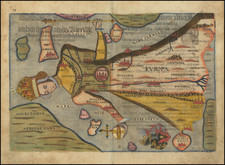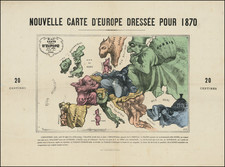Rare serio-comic map of the Crimean War, published in Hamburg.
Fine example of this important and apparently unrecorded caricature map of Europe in about 1856. This map is likely the first separately issued propaganda caricature map of its type, launching a genre of satirical maps which would become very popular throughout Europe over the course of the next 70 years.
The map shows the political situation at the end of the Crimean War. The Russian Bear, wearing the Imperial crown labelled "despotism" and brandishing a cat-o-nine-tails whip, strides eastwards but looks westward over its shoulder towards an enslaved, chained Polish maiden on her knees. The toes of the Russian bear's right foot take the form of the Crimean peninsula, where the French and English fleets gather in readiness to clip her claws, in opposition to the Russian fleet, which lies further to the East and is described as nicht sichtbar (not visible) - a reference to the Treaty of Paris [March 1856] by which the Crimean War was concluded and under whose terms Russia was forbidden to maintain a naval fleet in the Black Sea.
The Caucasus appear as a series of cork-exploding volcanoes, a reference to the perennial political unrest in these regions. To the West, the regions of European Turkey (the Balkans) appear in the form of a Turkey wearing a tasselled fez, her left claw clutching a bottle labelled Constantinople (a Bottle of Port (?) - Port being the name given to the Sultan of Turkey), which bridges the Bosphorus and connects to Asiatic Turkey (Anatolia). The latter takes on the form of a sleepy camel head. The turkey's right claw brings down a candle-snuffer over Greece, perhaps a reference to the snuffing out of Greek political independence.
To the North of European Turkey, the double-headed eagle of Austria, looks both East and West, its coat of arms split in two, a reference to Austria's ambivalent diplomatic stance vis-a-vis Russia. Despite a long tradition of diplomatic co-operation with Russia, especially after Russian support for the Austrians during the Revolutions of 1848 and 1850, Austria still feared Russian expansion and influence in the Balkans. In July 1853 ,Russia occupied the Ottoman principalities of Moldavia and Walachia. Following the declaration of war by Turkey against Russia in October 1853, the conflict spiralled into a pan-European conflict. There were numerous projects and proposals put forward by the European powers to Russia to try to prevent full-scale war. One of the most famous of these was the so-called "Vienna Note", shown amid the numerous documents tucked into the wing feathers of the Austrian Eagle. It was only through Austria twice threatening to intervene militarily against Russia on the side of the European powers that Russian political ambitions in the Balkans were checked and the Russian Tsar brought to the negotiation table. The Vienna Conference remained in session throughout the Crimean campaign in 1854-1855 and culminated with the Treaty of Paris in March 1856.
To the East of the Austrian eagle, a hooded Hungarian monk plunges a dagger into the Serbian regions located on the back of the European Turkey. To the North Prussia appears as a conjoined Punch and Judy figure lying on its back, its German neighbor shown as a series of male faces, characterized by a Bavarian beer tankard and a meerschaum pipe.
Further west, France appears as the Imperial Eagle (a reference to its ruler, the Emperor Napoleon III) in military uniform, ceremonial tri-color sash and sword, and shouldering a rifle. The British Isles take the form of an armed lion, Wales a small rabbit, and Ireland a ragged peasant figure. Italy takes on the form of a running dog, wearing the papal crown, its rear leg chained to a cooking pot that represents Sicily. The islands of Corsica and Sardinai take the form of comical smiling heads. In Scandinavia, the different countries take on the shape of further comical figures. An English fleet is shown steaming into the Gulf of Finland to threaten the Russian Baltic ports, Russia, a further indication of the Britsh Prime Minister Palmerston's use of so-called "gunboat diplomacy" .
In the Iberian peninsula, a coy Spanish girl hides her features behind a fan, adjacent to a Spanish dog ready to pounce on the British colony of Gibraltar. The annotations and amusing country character sketches within this wonderful map would certainly merit further study in order to clarify its deeper political and satirical nuances. The Publishers, Verlag B S Berendsohn, appear to have been well-known and successful printers and book publishers in Hamburg from the 1840's onwards and throughout the second half of the century.









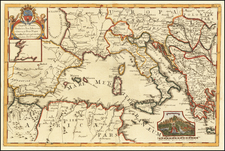
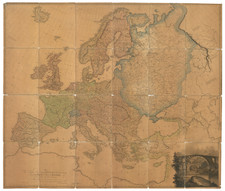
![[Course of the Rhine River] Corso del Reno Parte Septentrio [and] Corso del Reno Parte Meridionale . . . 1690](https://storage.googleapis.com/raremaps/img/small/73095.jpg)
